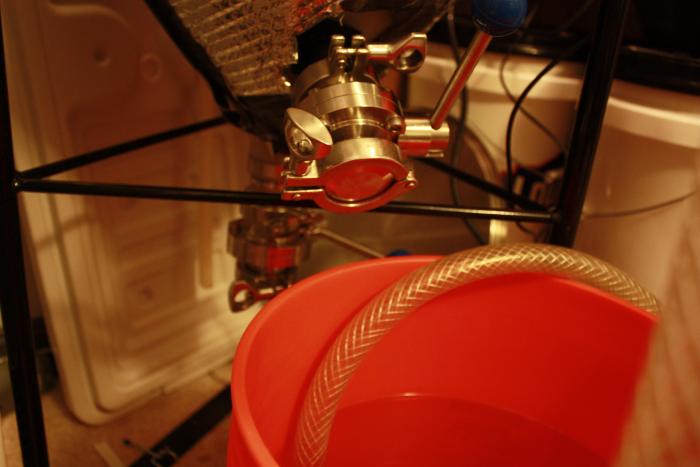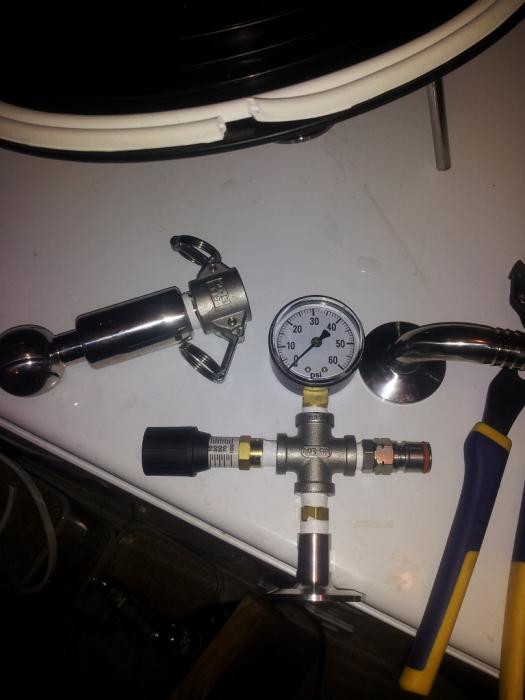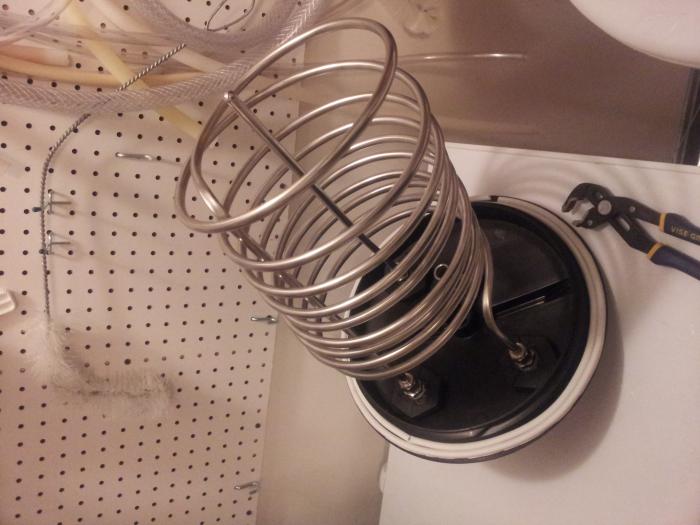Inspired by all of the topics in
https://www.homebrewtalk.com/f51/super-simple-15g-plastic-conical-276378/
and
https://www.homebrewtalk.com/f51/ebay-aquarium-temp-controller-build-163849/
I built an insulated plastic conical fermenter.
- Purchased inductor (MDPE cone) and stand from RuralKing
- Use old Home Depot mash tun as cooler to store ice (I use a bigger 70 qt rectangular cooler for 10 gallon batches)
- Used aquarium temperature controller, hobby box, small thermister from DigiKey (that fits in a thermowell) that I soldered to a mono audio cable with leftover wiring to build a simple temp controller.
- 25 ft stainless steel wort chiller to immerse in fermenting beer
- Use pump that came with Mark's Keg Washer (simple pond pump) to recirculate ice water through beer during fermentation.
- 1/3 HP pump with CIP spray ball on camlock. Use Iodophor to sanitize before pouring wort, and PBW to clean up system. The CIP is only used for cleanup and santization, but removed during fermentation.
- A 3/4" triclamp elbow is used to recirculate cleaner sanitizer, and as a blowoff tube. I sealed with silicone and weather stripping so that I can fermented with blowoff, but also maintain pressure of a few PSI inside conical (see photo of homemade spunding valve)
- Homemade spunding valve also has ball lock gas post so that I can top off CO2 after dumping yeast, or when I have extended primary on a lager and want to be paranoid.
- Simple insulation from Home Depot duct taped.
I use lots of ice via pump to chill beer to pitching temp, dump trub, aerate, then pitch yeast. To maintain temps, I change out frozen 2L bottles of ice once or twice a day, depending on the activity of yeast.
The bling factor of this build was the stainless triclovers. However, if I ever upgrade to a stainless conical, the fittings are fully translatable. I've been so happy once I got this set up, my interest in a stainless system has diminished; this fully temperature-controlled system with spunding was cheaper than a barebones stainless conical without fittings like the Brewhemoth or Blichmann. Plus I can really see when the CIP cleans out all krausen lines with the large lide opening, and fully disassemble, clean and sanitize threads and parts. If I ever had problems with the plastic cone, the replacement is a mere $60 and very briefly drill holes again.
To install the side pickup, I used a Viton gasket insead of normal EPDM or Buna-N since it's immersed in beer. Otherwise it's all silicone, stainless, and the plastic conical.
Doesn't hurt that the outside is covered in insulation. During parties, nobody suspects it's plastic until I tell them.
Beers fermented so far (all 10 gallons):
- IPA, Chico at 66 F
- Kolsch, WY1007 at 60 F
- Oktoberfest (in progress) at 50 F, while my house is 74 F in July (notice the temp controller hovering near 10 C, this is after 36 hours with active fermentation inside)
You could tell I was getting progressively confident with the fermenter's temp control abilities.
If anybody's considering a conical, think about building a plastic one. It's easy to drill plastic, plus the insulation is the real key to excellent temperature control without buying a second large freezer. I think it's more efficient to transfer energy directly into the wort rather than the surrounding air. During active primary with yeast swimming around, I think it's especially efficient to avoid any temperature gradients.
I like the conical for:
- Dumping trub in the fermenter
- Giving friends viable yeast from a recent batch (I normally propagate my own with different strains between batches)
- Bulk fermenting 10 G at one time, instead of two carboys
- Filling two cornys with the side pickup at the fermenter rather than moving the fermenter(s) around
- Less left-behind waste in the fermenter, I leave behind just about a qt of material below the side pickup.





https://www.homebrewtalk.com/f51/super-simple-15g-plastic-conical-276378/
and
https://www.homebrewtalk.com/f51/ebay-aquarium-temp-controller-build-163849/
I built an insulated plastic conical fermenter.
- Purchased inductor (MDPE cone) and stand from RuralKing
- Use old Home Depot mash tun as cooler to store ice (I use a bigger 70 qt rectangular cooler for 10 gallon batches)
- Used aquarium temperature controller, hobby box, small thermister from DigiKey (that fits in a thermowell) that I soldered to a mono audio cable with leftover wiring to build a simple temp controller.
- 25 ft stainless steel wort chiller to immerse in fermenting beer
- Use pump that came with Mark's Keg Washer (simple pond pump) to recirculate ice water through beer during fermentation.
- 1/3 HP pump with CIP spray ball on camlock. Use Iodophor to sanitize before pouring wort, and PBW to clean up system. The CIP is only used for cleanup and santization, but removed during fermentation.
- A 3/4" triclamp elbow is used to recirculate cleaner sanitizer, and as a blowoff tube. I sealed with silicone and weather stripping so that I can fermented with blowoff, but also maintain pressure of a few PSI inside conical (see photo of homemade spunding valve)
- Homemade spunding valve also has ball lock gas post so that I can top off CO2 after dumping yeast, or when I have extended primary on a lager and want to be paranoid.
- Simple insulation from Home Depot duct taped.
I use lots of ice via pump to chill beer to pitching temp, dump trub, aerate, then pitch yeast. To maintain temps, I change out frozen 2L bottles of ice once or twice a day, depending on the activity of yeast.
The bling factor of this build was the stainless triclovers. However, if I ever upgrade to a stainless conical, the fittings are fully translatable. I've been so happy once I got this set up, my interest in a stainless system has diminished; this fully temperature-controlled system with spunding was cheaper than a barebones stainless conical without fittings like the Brewhemoth or Blichmann. Plus I can really see when the CIP cleans out all krausen lines with the large lide opening, and fully disassemble, clean and sanitize threads and parts. If I ever had problems with the plastic cone, the replacement is a mere $60 and very briefly drill holes again.
To install the side pickup, I used a Viton gasket insead of normal EPDM or Buna-N since it's immersed in beer. Otherwise it's all silicone, stainless, and the plastic conical.
Doesn't hurt that the outside is covered in insulation. During parties, nobody suspects it's plastic until I tell them.
Beers fermented so far (all 10 gallons):
- IPA, Chico at 66 F
- Kolsch, WY1007 at 60 F
- Oktoberfest (in progress) at 50 F, while my house is 74 F in July (notice the temp controller hovering near 10 C, this is after 36 hours with active fermentation inside)
You could tell I was getting progressively confident with the fermenter's temp control abilities.
If anybody's considering a conical, think about building a plastic one. It's easy to drill plastic, plus the insulation is the real key to excellent temperature control without buying a second large freezer. I think it's more efficient to transfer energy directly into the wort rather than the surrounding air. During active primary with yeast swimming around, I think it's especially efficient to avoid any temperature gradients.
I like the conical for:
- Dumping trub in the fermenter
- Giving friends viable yeast from a recent batch (I normally propagate my own with different strains between batches)
- Bulk fermenting 10 G at one time, instead of two carboys
- Filling two cornys with the side pickup at the fermenter rather than moving the fermenter(s) around
- Less left-behind waste in the fermenter, I leave behind just about a qt of material below the side pickup.








